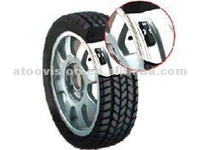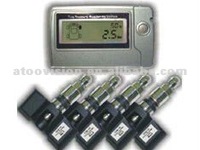- Auto Lighting System[10]
- Navigation & GPS[1]
- Wheel Parts[2]
- Auto Sensors[7]
- Contact Person : Ms. Chou Daly
- Company Name : Guangzhou Super ATOO Electronics Technology Co., Ltd.
- Tel : 86-20-28894225
- Fax : 86-20-39989030
- Address : Guangdong,guangzhou,Room 1909, Aoyuan Plaza, Panyu District
- Country/Region : China
- Zip : 511431
tire pressure montoring system (TPMS)/ car used/ 4 sensors
What is TPMS?
Direct TPMS is a warning system that warns a vehicle's operator of an unsafe change in the air pressure in one or more of the tires. Readings are provided by pressure sensing transmitters mounted inside each tire and sent to a central computer (ECU) for display on the dashboard. A warning indicator light on the instrument panel and an audible warning notify the driver if a 25% drop in pressure occurs.
How do I know if my vehicle is equipped with TPMS?
In the U.S., if you purchased a car or light duty vehicle under 10,000 lbs, manufactured after September 1, 2007, you have TPMS. If your model was manufactured after October 5, 2005, you may have TPMS. Also, prior to the legislation, some higher-end vehicles also came equipped with TPMS as a premium option. Among other matters, within TREAD Act of 2000, the U.S. federal government mandated the required implementation of TPMS on all new vehicles in the following phased rollout:
20% of new vehicles from Oct 5, 2005–Aug 31, 200670% of new vehicles from Sept 1, 2006–Aug 31, 2007100% of new vehicles from Sept 1, 2007 and beyond
There are several ways to determine if your vehicle is equipped with TPMS. The easiest include checking the owner's manual and watching the dashboard indicator lights at startup. Turn the vehicle ignition switch to the "ON" or "AUX" position, or simply start the vehicle.
How does tire pressure affect my safety?
As most drivers check their tires only at service intervals and when problems occur, motorists can benefit greatly from a greater awareness of tire pressure and its effects on safety while driving. The National Highway Traffic Safety Administration (NHTSA) has estimated that 660 U.S. automobile accident fatalities annually are caused by underinflated tires. Dry and wet surface handling suffers with underinflated tires, including:
Skidding and loss of control of the vehicle in a pronounced curve, such as an off-ramp from the highway, or when taking any curve at a high speedHydroplaning on a wet surface, which can affect both stopping distance and skidding or loss of controlCrashes from flat tires or blowouts
Can TPMS reduce my carbon footprint?
Small contributions by many can make a big difference in total. Properly inflated tires have a positive environmental impact by releasing less carbon dioxide (CO2) into the atmosphere through better gas mileage and fuel efficiency. A reduction in CO2emissions contributes to reducing greenhouse gas emissions.By improving the gas mileage of your vehicle, you can greatly reduce your carbon emissions and overall impact on the environment.
What are the TPMS types?
Direct TPMS measures the actual pressure from within the tires, using a pressure sensor with a transmitter. An in-car receiver monitors the pressure, and notifies the driver if the pressure in any tire drops below a set level.
Indirect TPMS monitors tire pressure by using the vehicle's antilock braking system's wheel speed sensors. The system compares the rotation of the tires to one another, and will alert the system if one tire rotates at a different speed than the others. Because the system is indirect, it may trigger more false alerts.
What is the parameter of TPMS?
Monitor connect with car
Signal receiving frequency:433.92M
Working Voltage: 12~24V D
Working Current <40mA
Working temperature:-20~85°C
Size:85x36x18
Sensors
Transmitting frequency: 433.92M
Working voltage: 3V DC
Working current<3mA
Working temperateure-40~125°C
Output power<-20dBm
Pressure range: 0~13Bar
Sensor size : 63x34x2 Weight <40g
tire pressure montoring system (TPMS)/ car used/ 4 sensors


